fuel KIA RIO HATCHBACK 2012 Owners Manual
[x] Cancel search | Manufacturer: KIA, Model Year: 2012, Model line: RIO HATCHBACK, Model: KIA RIO HATCHBACK 2012Pages: 385, PDF Size: 9.68 MB
Page 7 of 385
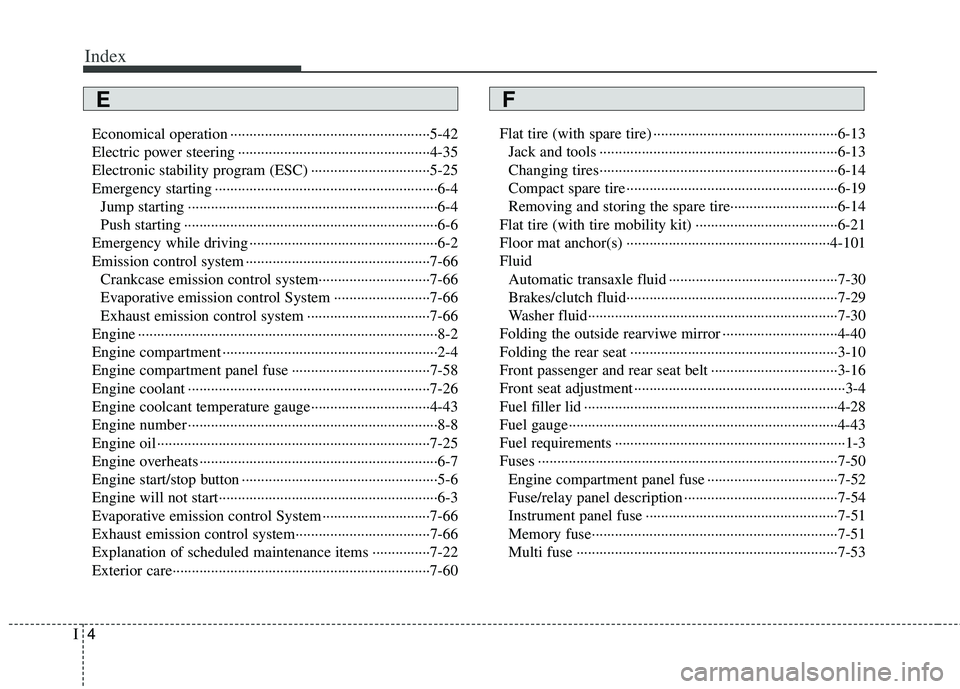
Index
4I
Economical operation ··················\
··················\
················5-42
Electric power steering ··················\
··················\
··············4-35
Electronic stability program (ESC) ··················\
·············5-25
Emergency starting ··················\
··················\
··················\
····6-4Jump starting ··················\
··················\
··················\
···········6-4
Push starting ··················\
··················\
··················\
············6-6
Emergency while driving ··················\
··················\
·············6-2
Emission control system ··················\
··················\
············7-66 Crankcase emission control system··················\
···········7-66
Evaporative emission control System ··················\
·······7-66
Exhaust emission control system ··················\
··············7-66
Engine ··················\
··················\
··················\
··················\
······8-2
Engine compartment ··················\
··················\
··················\
··2-4
Engine compartment panel fuse ··················\
··················\
7-58
Engine coolant ··················\
··················\
··················\
·········7-26
Engine coolcant temperature gauge··················\
·············4-43
Engine number ··················\
··················\
··················\
···········8-8
Engine oil ··················\
··················\
··················\
·················7-25\
Engine overheats ··················\
··················\
··················\
········6-7
Engine start/stop button ··················\
··················\
···············5-6
Engine will not start··················\
··················\
··················\
···6-3
Evaporative emission control System ··················\
··········7-66
Exhaust emission control system··················\
·················7-66\
Explanation of scheduled maintenance items ···············7-22
Exterior care··················\
··················\
··················\
·············7-60 Flat tire (with spare tire) ··················\
··················\
············6-13
Jack and tools ··················\
··················\
··················\
········6-13
Changing tires··················\
··················\
··················\
········6-14
Compact spare tire ··················\
··················\
··················\
·6-19
Removing and storing the spare tire···········\
·················6-14\
Flat tire (with tire mobility kit) ··················\
··················\
·6-21
Floor mat anchor(s) ··················\
··················\
·················4-10\
1
Fluid Automatic transaxle fluid ··················\
··················\
········7-30
Brakes/clutch fluid··················\
··················\
··················\
·7-29
Washer fluid··················\
··················\
··················\
···········7-30
Folding the outside rearviwe mirror ··················\
············4-40
Folding the rear seat ··················\
··················\
··················\
3-10
Front passenger and rear seat belt ··················\
···············3-16
Front seat adjustment ··················\
··················\
··················\
·3-4
Fuel filler lid ··················\
··················\
··················\
············4-28
Fuel gauge··················\
··················\
··················\
················4-43
Fuel requirements ··················\
··················\
··················\
······1-3
Fuses ··················\
··················\
··················\
··················\
······7-50 Engine compartment panel fuse ··················\
················7-52
Fuse/relay panel description ··················\
··················\
····7-54
Instrument panel fuse ··················\
··················\
··············7-51
Memory fuse··················\
··················\
··················\
··········7-51
Multi fuse ··················\
··················\
··················\
··············7-53
FE
Page 8 of 385
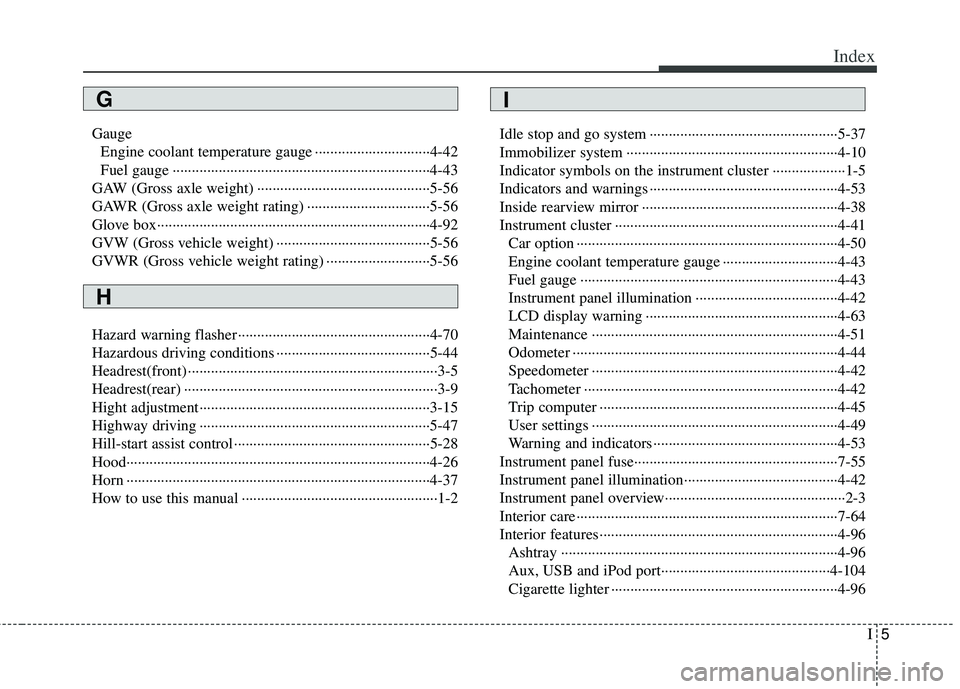
I5
Index
GaugeEngine coolant temperature gauge ··················\
············4-42
Fuel gauge ··················\
··················\
··················\
·············4-43
GAW (Gross axle weight) ··················\
··················\
·········5-56
GAWR (Gross axle weight rating) ··················\
··············5-56
Glove box··················\
··················\
··················\
·················4-92\
GVW (Gross vehicle weight) ··················\
··················\
····5-56
GVWR (Gross vehicle weight rating) ··················\
·········5-56
Hazard warning flasher ··················\
··················\
··············4-70
Hazardous driving conditions ··················\
··················\
····5-44
Headrest(front) ··················\
··················\
··················\
···········3-5
Headrest(rear) ··················\
··················\
··················\
············3-9
Hight adjustment··················\
··················\
··················\
······3-15
Highway driving ··················\
··················\
··················\
······5-47
Hill-start assist control ··················\
··················\
···············5-28
Hood··················\
··················\
··················\
··················\
·······4-26
Horn ··················\
··················\
··················\
··················\
·······4-37
How to use this manual ··················\
··················\
···············1-2 Idle stop and go system ··················\
··················\
·············5-37
Immobilizer system ··················\
··················\
··················\
·4-10
Indicator symbols on the instrument cluster ··················\
·1-5
Indicators and warnings ··················\
··················\
·············4-53
Inside rearview mirror ··················\
··················\
···············4-38
Instrument cluster ··················\
··················\
··················\
····4-41
Car option ··················\
··················\
··················\
··············4-50
Engine coolant temperature gauge ··················\
············4-43
Fuel gauge ··················\
··················\
··················\
·············4-43
Instrument panel illumination ··················\
··················\
·4-42
LCD display warning ··················\
··················\
··············4-63
Maintenance ··················\
··················\
··················\
··········4-51
Odometer ··················\
··················\
··················\
···············4-44
Speedometer ··················\
··················\
··················\
··········4-42
Tachometer ··················\
··················\
··················\
············4-42
Trip computer ··················\
··················\
··················\
········4-45
User settings ··················\
··················\
··················\
··········4-49
Warning and indicators ··················\
··················\
············4-53
Instrument panel fuse··················\
··················\
·················7-55\
Instrument panel illumination··················\
··················\
····4-42
Instrument panel overview··················\
··················\
···········2-3
Interior care··················\
··················\
··················\
··············7-64
Interior features··················\
··················\
··················\
········4-96 Ashtray ··················\
··················\
··················\
··················\
4-96
Aux, USB and iPod port··················\
··················\
········4-104
Cigarette lighter ··················\
··················\
··················\
·····4-96
G
H
I
Page 14 of 385
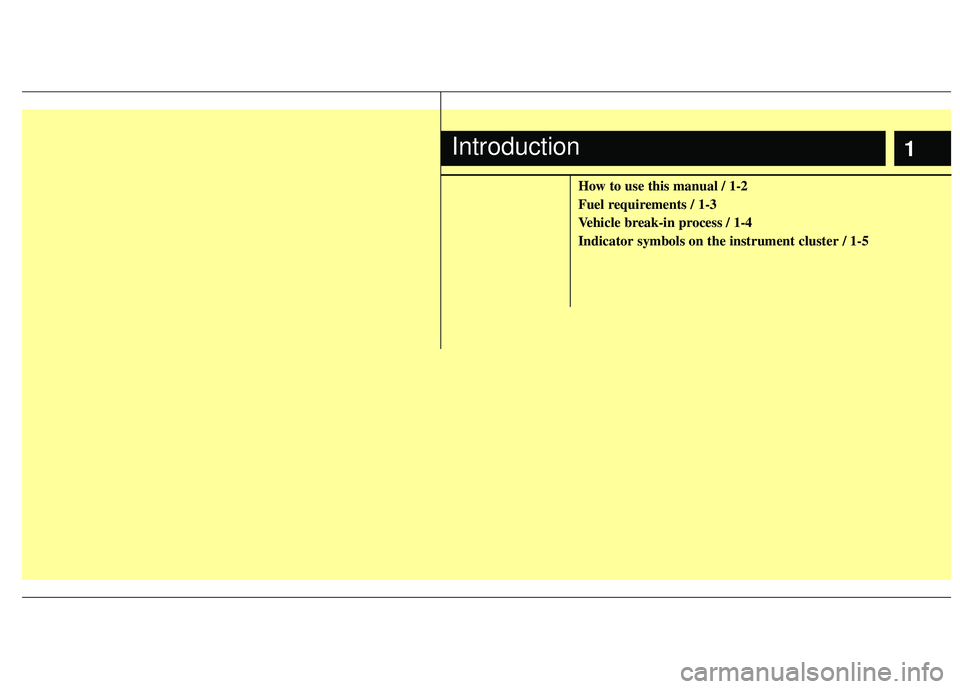
1
How to use this manual / 1-2
Fuel requirements / 1-3
Vehicle break-in process / 1-4
Indicator symbols on the instrument cluster / 1-5
Introduction
Page 16 of 385
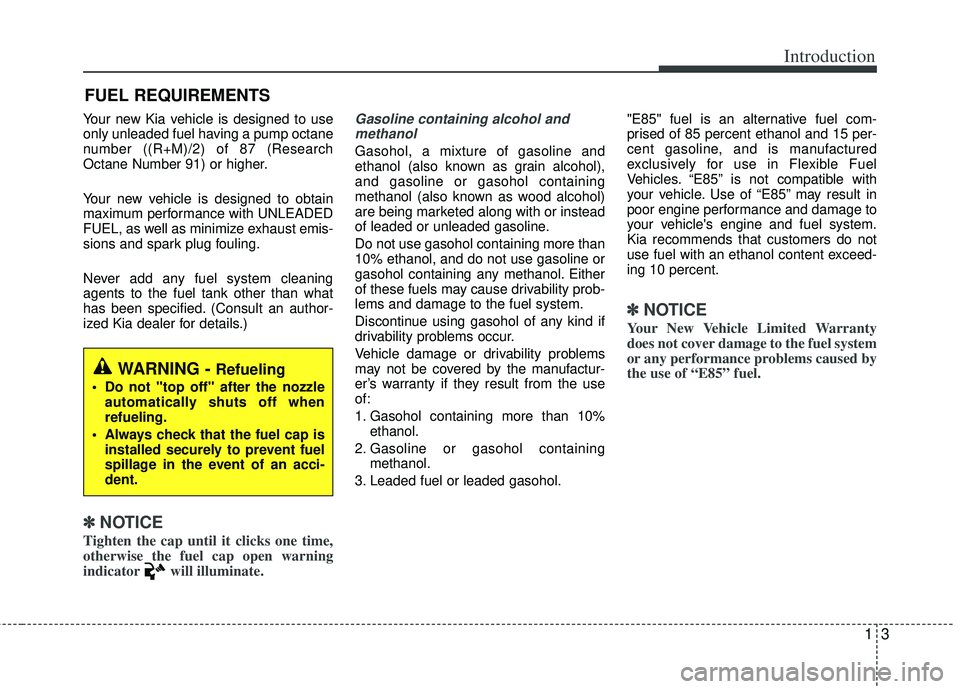
13
Introduction
Your new Kia vehicle is designed to use
only unleaded fuel having a pump octane
number ((R+M)/2) of 87 (Research
Octane Number 91) or higher.
Your new vehicle is designed to obtain
maximum performance with UNLEADED
FUEL, as well as minimize exhaust emis-
sions and spark plug fouling.
Never add any fuel system cleaning
agents to the fuel tank other than what
has been specified. (Consult an author-
ized Kia dealer for details.)
✽ ✽
NOTICE
Tighten the cap until it clicks one time,
otherwise the fuel cap open warning
indicator will illuminate.
Gasoline containing alcohol and
methanol
Gasohol, a mixture of gasoline and
ethanol (also known as grain alcohol),
and gasoline or gasohol containing
methanol (also known as wood alcohol)
are being marketed along with or instead
of leaded or unleaded gasoline.
Do not use gasohol containing more than
10% ethanol, and do not use gasoline or
gasohol containing any methanol. Either
of these fuels may cause drivability prob-
lems and damage to the fuel system.
Discontinue using gasohol of any kind if
drivability problems occur.
Vehicle damage or drivability problems
may not be covered by the manufactur-
er’s warranty if they result from the use
of:
1. Gasohol containing more than 10% ethanol.
2. Gasoline or gasohol containing methanol.
3. Leaded fuel or leaded gasohol. "E85" fuel is an alternative fuel com-
prised of 85 percent ethanol and 15 per-
cent gasoline, and is manufactured
exclusively for use in Flexible Fuel
Vehicles. “E85” is not compatible with
your vehicle. Use of “E85” may result in
poor engine performance and damage to
your vehicle's engine and fuel system.
Kia recommends that customers do not
use fuel with an ethanol content exceed-
ing 10 percent.
✽ ✽
NOTICE
Your New Vehicle Limited Warranty
does not cover damage to the fuel system
or any performance problems caused by
the use of “E85” fuel.
FUEL REQUIREMENTS
WARNING - Refueling
• Do not "top off" after the nozzle
automatically shuts off when
refueling.
Always check that the fuel cap is installed securely to prevent fuel
spillage in the event of an acci-
dent.
Page 17 of 385
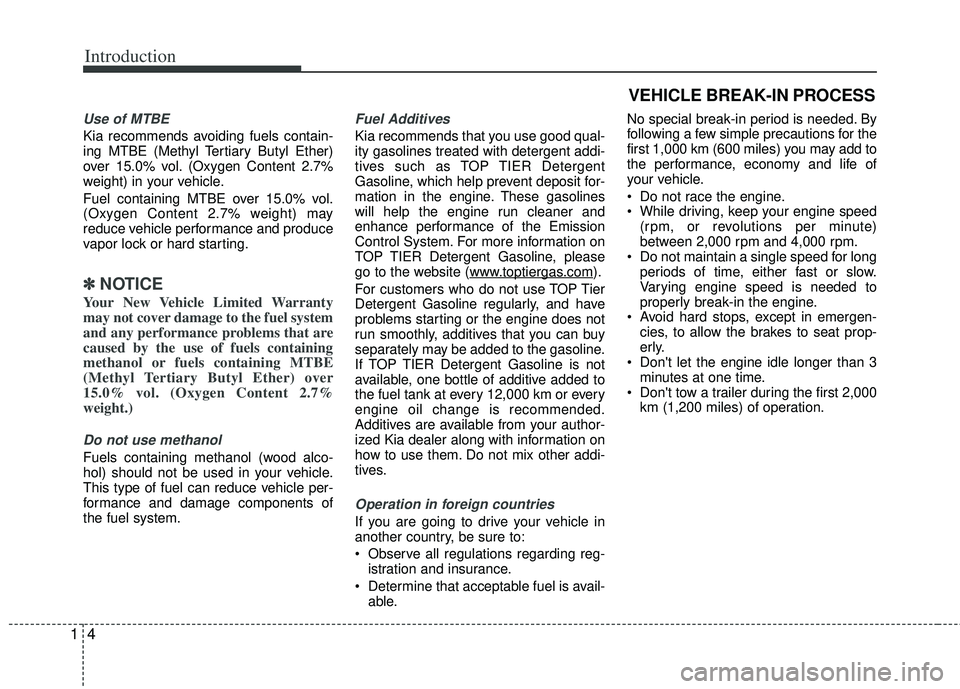
Introduction
41
Use of MTBE
Kia recommends avoiding fuels contain-
ing MTBE (Methyl Tertiary Butyl Ether)
over 15.0% vol. (Oxygen Content 2.7%
weight) in your vehicle.
Fuel containing MTBE over 15.0% vol.
(Oxygen Content 2.7% weight) may
reduce vehicle performance and produce
vapor lock or hard starting.
✽ ✽
NOTICE
Your New Vehicle Limited Warranty
may not cover damage to the fuel system
and any performance problems that are
caused by the use of fuels containing
methanol or fuels containing MTBE
(Methyl Tertiary Butyl Ether) over
15.0% vol. (Oxygen Content 2.7%
weight.)
Do not use methanol
Fuels containing methanol (wood alco-
hol) should not be used in your vehicle.
This type of fuel can reduce vehicle per-
formance and damage components of
the fuel system.
Fuel Additives
Kia recommends that you use good qual-
ity gasolines treated with detergent addi-
tives such as TOP TIER Detergent
Gasoline, which help prevent deposit for-
mation in the engine. These gasolines
will help the engine run cleaner and
enhance performance of the Emission
Control System. For more information on
TOP TIER Detergent Gasoline, please
go to the website (www
.toptiergas.com).
For customers who do not use TOP Tier
Detergent Gasoline regularly, and have
problems starting or the engine does not
run smoothly, additives that you can buy
separately may be added to the gasoline.
If TOP TIER Detergent Gasoline is not
available, one bottle of additive added to
the fuel tank at every 12,000 km or every
engine oil change is recommended.
Additives are available from your author-
ized Kia dealer along with information on
how to use them. Do not mix other addi-
tives.
Operation in foreign countries
If you are going to drive your vehicle in
another country, be sure to:
Observe all regulations regarding reg- istration and insurance.
Determine that acceptable fuel is avail- able. No special break-in period is needed. By
following a few simple precautions for the
first 1,000 km (600 miles) you may add to
the performance, economy and life of
your vehicle.
Do not race the engine.
While driving, keep your engine speed
(rpm, or revolutions per minute)
between 2,000 rpm and 4,000 rpm.
Do not maintain a single speed for long periods of time, either fast or slow.
Varying engine speed is needed to
properly break-in the engine.
Avoid hard stops, except in emergen- cies, to allow the brakes to seat prop-
erly.
Don't let the engine idle longer than 3 minutes at one time.
Don't tow a trailer during the first 2,000 km (1,200 miles) of operation.
VEHICLE BREAK-IN PROCESS
Page 18 of 385
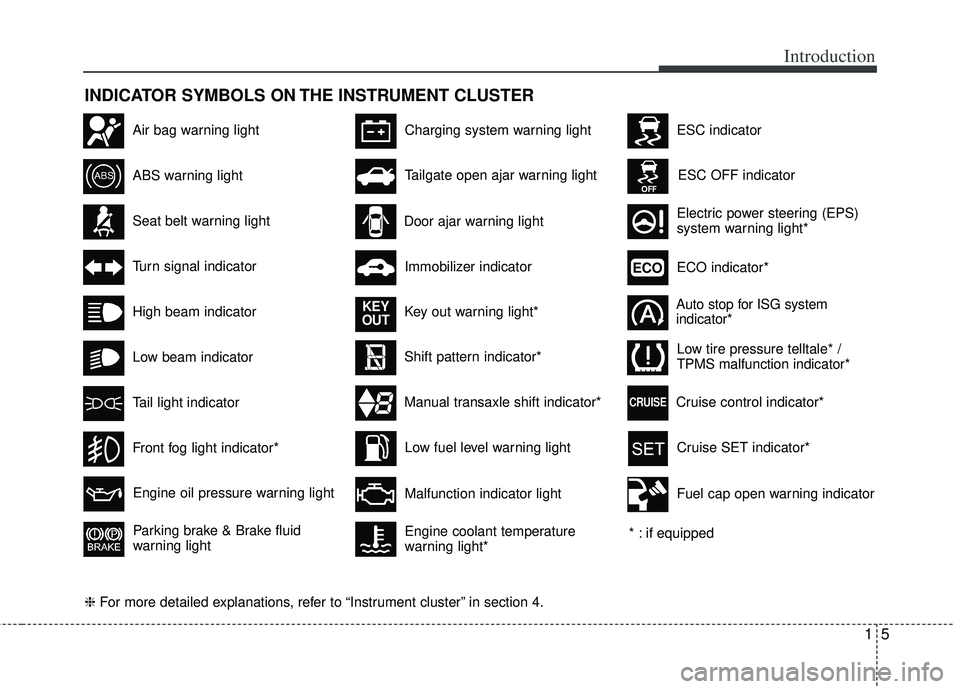
15
Introduction
INDICATOR SYMBOLS ON THE INSTRUMENT CLUSTER
Seat belt warning light
High beam indicator
Turn signal indicator
ABS warning light
Parking brake & Brake fluid
warning light
Engine oil pressure warning light
ESC indicator
ESC OFF indicator
Malfunction indicator light
Air bag warning light
Immobilizer indicator
Low fuel level warning light* : if equipped
Charging system warning light
Tail light indicator
Tailgate open ajar warning light
Front fog light indicator*
Electric power steering (EPS)
system warning light*Door ajar warning light
Shift pattern indicator*
Manual transaxle shift indicator* Key out warning light*
KEY
OUT
ECO indicator*ECO
Auto stop for ISG system
indicator*
Low beam indicator
Engine coolant temperature
warning light*
❈For more detailed explanations, refer to “Instrument cluster” in section 4. Low tire pressure telltale* /
TPMS malfunction indicator*
Cruise SET indicator*
Cruise control indicator*
CRUISE
Fuel cap open warning indicator
Page 20 of 385
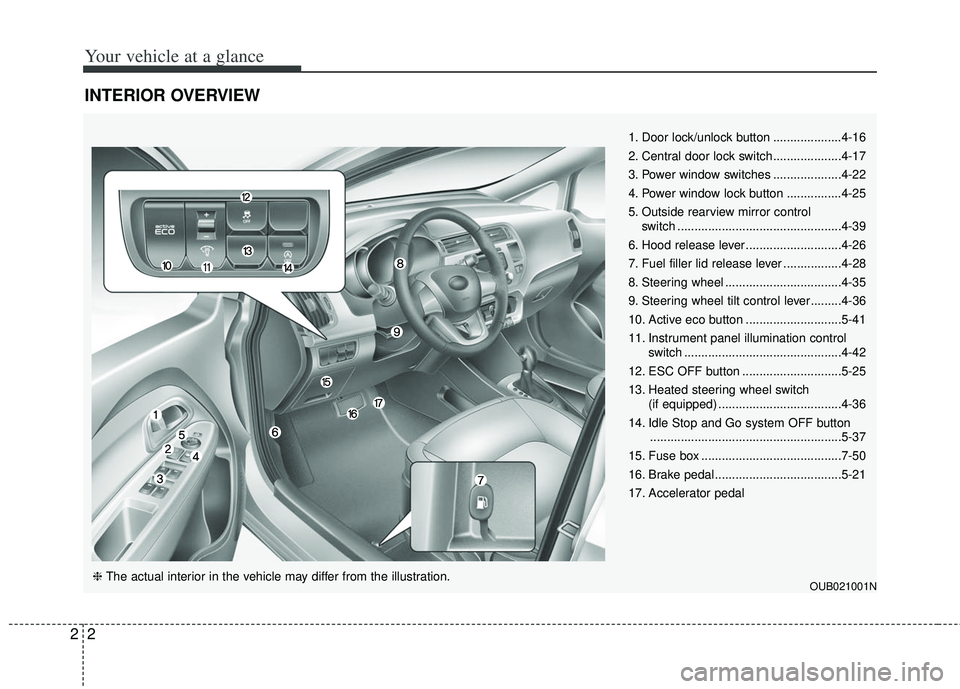
Your vehicle at a glance
22
INTERIOR OVERVIEW
OUB021001N
1. Door lock/unlock button ....................4-16
2. Central door lock switch....................4-17
3. Power window switches ....................4-22
4. Power window lock button ................4-25
5. Outside rearview mirror control switch ................................................4-39
6. Hood release lever ............................4-26
7. Fuel filler lid release lever .................4-28
8. Steering wheel ..................................4-35
9. Steering wheel tilt control lever.........4-36
10. Active eco button ............................5-41
11. Instrument panel illumination control switch ..............................................4-42
12. ESC OFF button .............................5-25
13. Heated steering wheel switch (if equipped) ....................................4-36
14. Idle Stop and Go system OFF button ........................................................5-37
15. Fuse box .........................................7-50
16. Brake pedal .....................................5-21
17. Accelerator pedal
❈ The actual interior in the vehicle may differ from the illustration.
Page 76 of 385
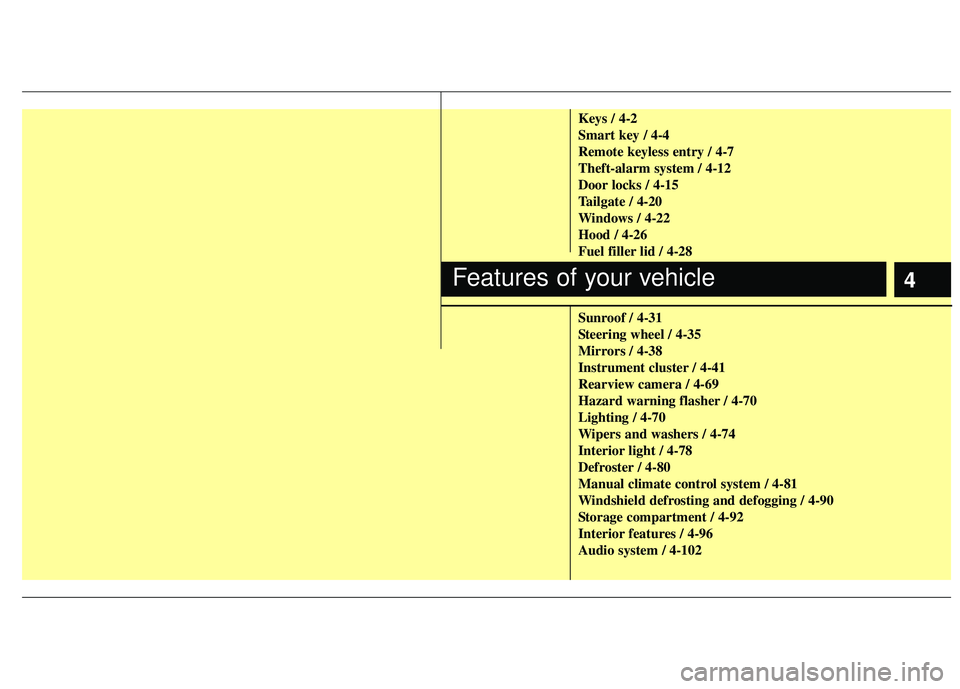
4
Keys / 4-2
Smart key / 4-4
Remote keyless entry / 4-7
Theft-alarm system / 4-12
Door locks / 4-15
Tailgate / 4-20
Windows / 4-22
Hood / 4-26
Fuel filler lid / 4-28
Sunroof / 4-31
Steering wheel / 4-35
Mirrors / 4-38
Instrument cluster / 4-41
Rearview camera / 4-69
Hazard warning flasher / 4-70
Lighting / 4-70
Wipers and washers / 4-74
Interior light / 4-78
Defroster / 4-80
Manual climate control system / 4-81
Windshield defrosting and defogging / 4-90
Storage compartment / 4-92
Interior features / 4-96
Audio system / 4-102
Features of your vehicle
Page 103 of 385
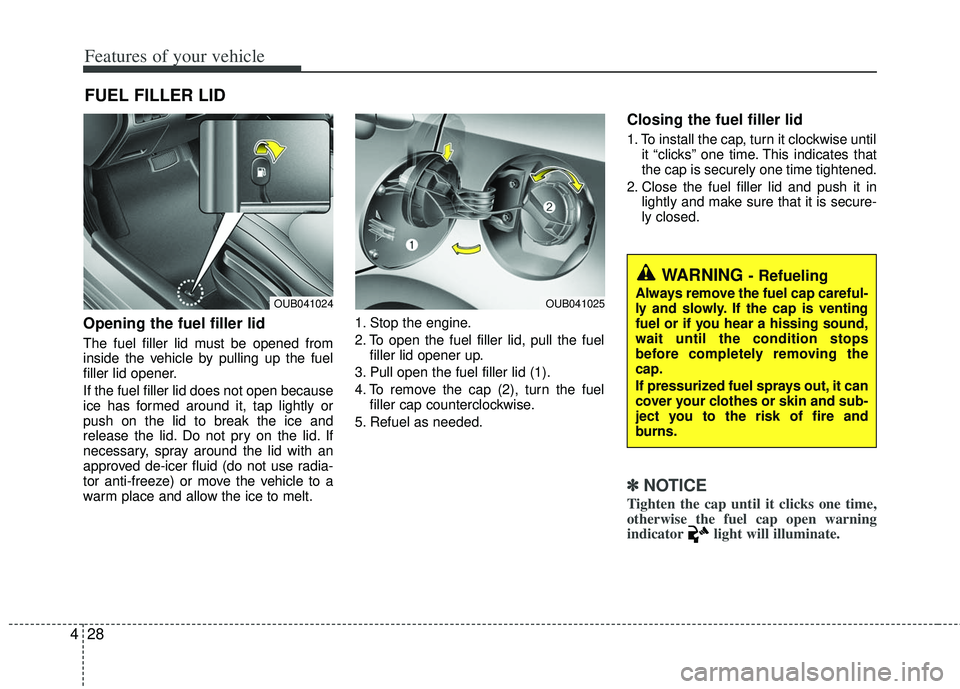
Features of your vehicle
28
4
Opening the fuel filler lid
The fuel filler lid must be opened from
inside the vehicle by pulling up the fuel
filler lid opener.
If the fuel filler lid does not open because
ice has formed around it, tap lightly or
push on the lid to break the ice and
release the lid. Do not pry on the lid. If
necessary, spray around the lid with an
approved de-icer fluid (do not use radia-
tor anti-freeze) or move the vehicle to a
warm place and allow the ice to melt. 1. Stop the engine.
2. To open the fuel filler lid, pull the fuel
filler lid opener up.
3. Pull open the fuel filler lid (1).
4. To remove the cap (2), turn the fuel filler cap counterclockwise.
5. Refuel as needed.
Closing the fuel filler lid
1. To install the cap, turn it clockwise until it “clicks” one time. This indicates that
the cap is securely one time tightened.
2. Close the fuel filler lid and push it in lightly and make sure that it is secure-
ly closed.
✽ ✽
NOTICE
Tighten the cap until it clicks one time,
otherwise the fuel cap open warning
indicator light will illuminate.
FUEL FILLER LID
WARNING - Refueling
Always remove the fuel cap careful-
ly and slowly. If the cap is venting
fuel or if you hear a hissing sound,
wait until the condition stops
before completely removing the
cap.
If pressurized fuel sprays out, it can
cover your clothes or skin and sub-
ject you to the risk of fire and
burns.OUB041024OUB041025
Page 104 of 385
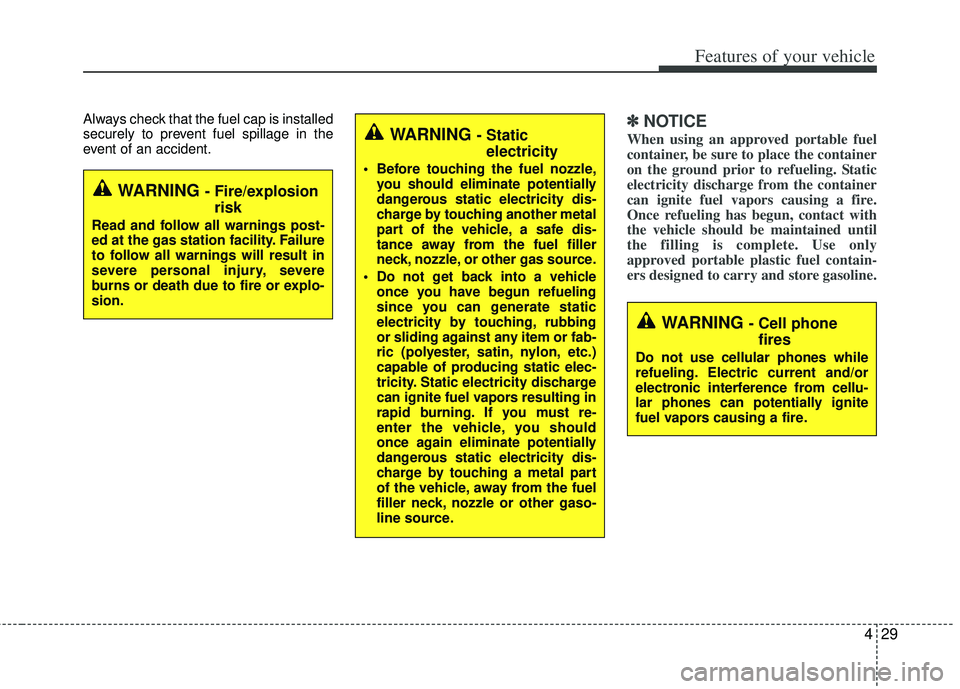
429
Features of your vehicle
Always check that the fuel cap is installed
securely to prevent fuel spillage in the
event of an accident.✽ ✽NOTICE
When using an approved portable fuel
container, be sure to place the container
on the ground prior to refueling. Static
electricity discharge from the container
can ignite fuel vapors causing a fire.
Once refueling has begun, contact with
the vehicle should be maintained until
the filling is complete. Use only
approved portable plastic fuel contain-
ers designed to carry and store gasoline.
WARNING - Fire/explosion
risk
Read and follow all warnings post-
ed at the gas station facility. Failure
to follow all warnings will result in
severe personal injury, severe
burns or death due to fire or explo-
sion.
WARNING - Cell phonefires
Do not use cellular phones while
refueling. Electric current and/or
electronic interference from cellu-
lar phones can potentially ignite
fuel vapors causing a fire.
WARNING - Static electricity
Before touching the fuel nozzle,
you should eliminate potentially
dangerous static electricity dis-
charge by touching another metal
part of the vehicle, a safe dis-
tance away from the fuel filler
neck, nozzle, or other gas source.
Do not get back into a vehicle once you have begun refueling
since you can generate static
electricity by touching, rubbing
or sliding against any item or fab-
ric (polyester, satin, nylon, etc.)
capable of producing static elec-
tricity. Static electricity discharge
can ignite fuel vapors resulting in
rapid burning. If you must re-
enter the vehicle, you should
once again eliminate potentially
dangerous static electricity dis-
charge by touching a metal part
of the vehicle, away from the fuel
filler neck, nozzle or other gaso-
line source.